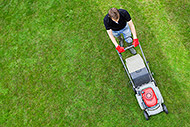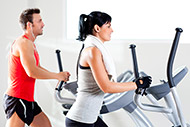
High-Intensity Interval Training (HIIT) is a workout that alternates vigorous cardio intervals with periods of lower intensity exercise. According to the American Council on Exercise, high-intensity intervals last anywhere from 30 seconds to three minutes while rest intervals are the same length or longer. Research shows that HIIT workouts are effective for improving aerobic and anaerobic fitness, improving insulin resistance, and decreasing belly and subcutaneous fat. In addition to the valuable health benefits, here are five more reasons to try HIIT.
You are short on time.
HIIT workouts are appealing because they are short duration making it easy to fit one into a busy schedule. If you push yourself towards a Rated Perceived Exertion (RPE) of 17 to 19 during the high-intensity intervals (about 80 to 95 percent of your maximum aerobic capacity), you can get an effective workout in only 15 to 20 minutes.
You need a challenge.
HIIT is ideal for taking your fitness to the next level. This type of exercise pushes you hard and then allows you to recover slightly before pushing hard again. While other cardio workouts may increase your heart rate, HIIT tests what you are capable of both mentally and physically.
Your weight loss has stalled.
Weight loss plateaus are unavoidable. When you hit one, your body needs a break from your exercise routine to boost calorie burn. Even though the rest periods allow you to catch your breath, the high-intensity sessions help to increase your energy expenditure (calories you burn) for the entire workout. If you are stuck in a rut of 45-60 minute cardio sessions, incorporating HIIT one or two days a week may be just what you need to break through your plateau.
You have limited space.
HIIT is often associated with sprints and stair climbing, but you can easily put together an intense workout in your living room. Jump squats, mountain climbers, jump rope, high knees, and boxing combos can serve as your high-intensity moves, followed by rest periods of marching or easy jogging in place. The key is to move quickly while incorporating higher impact movements to elevate your heart rate.
You need an inexpensive workout.
While HIIT can be done on treadmills and stationary bicycles, a watch with a timer and quality athletic shoes are all you need. Parks, trails, pools, and lakes can serve as venues for HIIT. Sprints, hill climbs, running stairs, fast swimming, and water jogging are all options for high-intensity intervals.
Sources



 5 Ways to Burn 300 Calories this Weekend
5 Ways to Burn 300 Calories this Weekend
 The Best Home and Garden Chores for Burning Calories
The Best Home and Garden Chores for Burning Calories
 5 Tips for Making Exercise a Habit
5 Tips for Making Exercise a Habit
 Best Ways to Stay Safe during Exercise in Hot Weather
Best Ways to Stay Safe during Exercise in Hot Weather
 11 Tips for Exercise Motivation
11 Tips for Exercise Motivation
 Signs You Need to Increase Exercise Intensity
Signs You Need to Increase Exercise Intensity
 Mistakes to Avoid When Setting Fitness Goals
Mistakes to Avoid When Setting Fitness Goals
 Essential Gear for Starting an Exercise Program
Essential Gear for Starting an Exercise Program

 Pinterest
Pinterest RSS Feed
RSS Feed